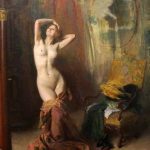
Friant was born in the commune of Dieuze in 1863. His father was a locksmith and mother a dressmaker. The wife of a chemist, Madame Parisot would hire the wife of Émile Friant’s father to design custom clothing. The Parisots took an early interest in the young Friant and treated him maternally, as they were without children of their own.
“La Petite Barque” With the defeat of the Second French Empire at hand, as part of the then-ongoing Franco-Prussian War, Dieuze was no longer under state control. Intensely distressed by this, Parisot intended to leave the commune for Nancy, but died shortly before having the chance. In 1871, Madame Parisot fled with Friant to Nancy; his biological family would follow later.
Friant Chooses Art Over Science
Friant was sent to the lycée to learn Latin, as Madame Parisot intended for him to follow in her husband’s footsteps and become a chemist. Meanwhile, friends of his biological father had suggested sending him to a municipal school of art because of his skill with the brush. Because of his poor work at the lycée, Friant requested permission to leave and focus on his art.
His father agreed, and the young Friant was placed under the guide of a private tutor who would arrange his academic work so that time remained for painting. Under the guidance of Louis-Théodore Devilly, director of a school in Nancy and a proponent of realism, Friant learned the art of still life and landscape painting.
Friant painted La Petite Barque at the age of 15. It was exhibited in Nancy and quickly became the center of public intrigue. The municipal council granted him permission to travel to Paris a year later. There, he studied under Alexandre Cabanel, who tutored him in creating oil sketches of historical works. Friant, becoming disenchanted by the academic style of the atelier method, returned to Nancy. Source: Wikipedia.




